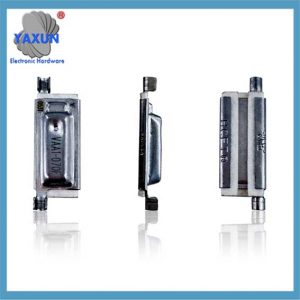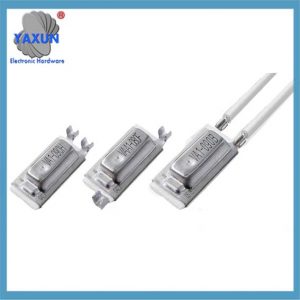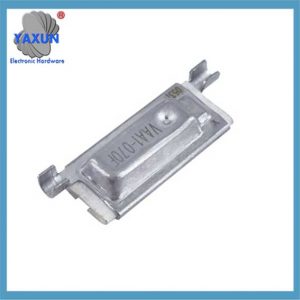A snap-action thermostat/thermal protector with the highest contact ratings of any of our controls. Suitable for use on 120/240 VAC loads. Available with variety of bi-metallic elements to enhance performance characteristics. Selecting Creep-Action Thermal Protectors requires an analysis of pole-and-throw specifications, set-point temperature, hysteresis, maximum current rating, maximum AC voltage rating, maximum DC voltage rating, and switch life.
Pole-and-throw specifications
Tiang tunggal, lemparan tunggal (SPST) switches make or break the connection of a single conductor in a single branch circuit. They have two terminals and are commonly referred to as “single pole” switches.
Tiang tunggal, double throw (SPDT) switches make or break the connection of a single conductor with either of two other single conductors. Often called “three-way switches,” SPDT devices have three terminals and are used in pairs.
Double pole, lemparan tunggal (DPST) switches make or break the connection of two circuit conductors in a single branch circuit and usually have four terminals.
Double pole, double throw (DPDT) switches make or break the connection of two conductors in two separate circuits. Most DPDT switches have six terminals and are available in either momentary or maintained contact versions.
Creep-Action Thermal Protectors with more than two poles are designed to split loads into separate circuits.
Creep-Action Thermal Protectors Set-point Temperature
Creep-Action Thermal Protectors Specification Guide Thermal switches and thermal protectors have a set point temperature that is either fixed or field adjustable. Titik setel adalah suhu terukur di mana perangkat mengalami perubahan keadaan yang terkait dengan pergerakan kontak listrik. Perangkat titik tetap diberi peringkat pada suhu tertentu, sementara perangkat yang dapat disesuaikan di lapangan memiliki kisaran suhu di mana titik setel dapat disesuaikan.
Creep-Action Thermal Protectors Hysteresis
Histeresis, juga disebut sebagai perbedaan suhu, adalah kisaran suhu terbatas di mana peralihan terjadi. Ini dirancang untuk mencegah sirkuit terus berubah antar negara bagian. Histeresis dari 0.5 C biasanya akan aktif 0.5 derajat melewati suhu set-point dan tidak mengubah keadaan lagi sampai suhu turun menjadi 0,5C di bawah suhu set-point.
Suhu Sekitar: The normal or typical temperature of the environment surrounding the device.
Reset Otomatis: A thermostat that automatically resets to its pre-trip contact configuration at a factory preset temperature.
Bimetal: Two metals with different rates of expansion molecularly bonded together to form a blade or disc for a thermostat.
Creep Action Thermostat: A thermostat with a bimetal blade that slowly makes the contacts or slowly breaks the contacts.
Current Derating: Term used to describe a predictable condition where increased current applied to a thermostat causes the device to open at a temperature below its set point. This condition is present only in Normally Closed bimetal thermostats that are both current and temperature sensitive.
Functioning Temperature: (TF of Tf) In reference to a thermal cutoff, as defined by IEC Standards, the temperature at which a Thermal Cutoff opens a circuit under a no load condition. The IEC tolerance is +0 C, -10 C.
Holding Temperature: (TH or Th) In reference to a thermal cutoff, the maximum temperature that a Thermal Cutoff can maintain Rated Current for a period of 168 hours with functioning.
Maximum Temperature: (TM or Tm) In reference to a thermal cutoff, the maximum temperature to which the device can be subjected for a period of ten minutes without resuming conductivity once it has opened.
Minimum Differential: (also known as deadband) The minimum number of degrees between the actual open and actual close temperatures.
Motor Protector: A thermal protector that is sensitive to both increases in current and increases in temperature.
Biasanya Tertutup (N.C.): Contacts open on temperature rise.
Biasanya Terbuka (N.O.): Contacts close on temperature rise.
One Shot: A device that, once activated at its preset temperature, cannot be reset. Available only in Normally Closed contact configuration.
Nilai Saat Ini: The maximum allowable current that a device can carry.
Nilai Tegangan: The maximum voltage that should be applied to a device.
Self-Hold Protector: A device that, upon opening, will not reset until power is removed from its circuit regardless of ambient temperature. Available only in Normally Closed contact configuration.
Snap Action Thermostat: A thermostat with a Bimetal element that snaps to close the contacts when the activation condition is experienced. This construction permits the clean break of loads.
Pemutusan Termal: A thermal cutoff is an electrical safety device that interrupts electric current when heated to a specific temperature.
Thermal Cutoff Fuse: A device that melts its internal element to open a circuit in an over-temperature condition. Also known as a thermal fuse, thermal protector fuse or thermal switch.
Thermal Protector: A Thermal Protector is a protective device built into a motor that provides over-current or over-temperature protection that disconnects power to the ballast if internal temperatures rise above the trip point. This protects motors from overheating. Types of switches include automatic rest, manual reset and resistance temperature detectors.
Toleransi: The allowable range above and below a nominal temperature.
 English
English Afrikaans
Afrikaans العربية
العربية বাংলা
বাংলা bosanski jezik
bosanski jezik Български
Български Català
Català 粤语
粤语 中文(简体)
中文(简体) 中文(漢字)
中文(漢字) Hrvatski
Hrvatski Čeština
Čeština Nederlands
Nederlands Eesti keel
Eesti keel Suomi
Suomi Français
Français Deutsch
Deutsch Ελληνικά
Ελληνικά हिन्दी; हिंदी
हिन्दी; हिंदी Magyar
Magyar Bahasa Indonesia
Bahasa Indonesia Italiano
Italiano 日本語
日本語 한국어
한국어 Latviešu valoda
Latviešu valoda Lietuvių kalba
Lietuvių kalba македонски јазик
македонски јазик Bahasa Melayu
Bahasa Melayu Norsk
Norsk پارسی
پارسی Polski
Polski Português
Português Română
Română Русский
Русский Cрпски језик
Cрпски језик Slovenčina
Slovenčina Slovenščina
Slovenščina Español
Español Svenska
Svenska ภาษาไทย
ภาษาไทย Türkçe
Türkçe Українська
Українська اردو
اردو Tiếng Việt
Tiếng Việt



